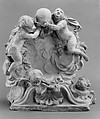Model for a Papal monument
Possibly by Peter Anton von Verschaffelt Flemish
The form is that of an overdoor displaying the tiara and keys—a time-honored type of papal monument but sketched here with such extreme flamboyance that the intended medium may have been stucco rather than marble. There is no identifying coat of arms, though the genial late Baroque style is characteristic of Roman art under Benedict XIV (1740–58). Among the sculptors protected by that pope was Peter Anton van Verschaffelt (1710–1793), Flemish born and French educated, who worked in Rome from 1737 to 1751 and afterward especially for the court at Mannheim. Similarities with putti in stucco by Verschaffelt on the facade of San Norberta in Rome and with a marble Genius of the Papacy at San Ciriaco in Ancona can be seen, especially in the rather self-contained putto at the left in this model, who is a tribute to the infantine forms popularized in Rome more than a century earlier by another sculptor of Flemish birth, François Duquesnoy. The asymmetrical concavity of the model occurs in one of Verschaffelt's first Mannheim works, an overdoor with Fame for the Jesuit Church. It is pointless to press an outright attribution, however, until more is known of Verschaffelt's manner of sketching. Esteemed for his highly finished treatment of marble, he is represented in the Museum's collection by his bust of an Englishman (1978. 3), a work of the Roman period (signed and dated 1740).
Due to rights restrictions, this image cannot be enlarged, viewed at full screen, or downloaded.

